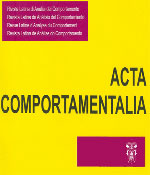Can we change, In verbal therapy, the stimulus control?
Main Article Content
Abstract
The functional analysis, carried out during behavior therapy, aims at identifying one or more classes of behavior that cause problems for the client, its antecedents and its consequences. Following the functional analysis we can focus the therapeutic work on changing the behavior patterns themselves, on changing its antecedents, or its consequences. In this article, the change of behavior antecedents is analyzed. One can ask if jt is possible to alter a contingency, which occurs outside the therapeutic session, in a clinic session. Can we affirm that the properties of an antecedent stimulus changes in a purely verbal therapeutic situation? Seemingly yes, but what are the behavioral processes involved in those changes? It is a verbal process. The change in the antecedents of the behavior, in therapy, happens when we identify the existence of a property of the discriminative stimulus that controls the response or class of responses that brought the client to therapy, and, verbally, we highlight other properties of the same stimulus, which control other responses that already exist in the client's repertoire. The concept of "supplementary stimulation" presented by Skinner in his book "Verbal Behavior" (1957) is used to explain this function of the Behavior Therapy. Examples of therapeutic interventions found in the literature and an example of therapeutic intervention carried out by the author were analyzed.
Article Details
Citas en Dimensions Service

<a rel="license" href="http://creativecommons.org/licenses/by-nc-sa/4.0/"><img alt="Licencia de Creative Commons" style="border-width:0" src="https://i.creativecommons.org/l/by-nc-sa/4.0/88x31.png" /></a><br />Este obra está bajo una <a rel="license" href="http://creativecommons.org/licenses/by-nc-sa/4.0/">licencia de Creative Commons Reconocimiento-NoComercial-CompartirIgual 4.0 Internacional</a>.
